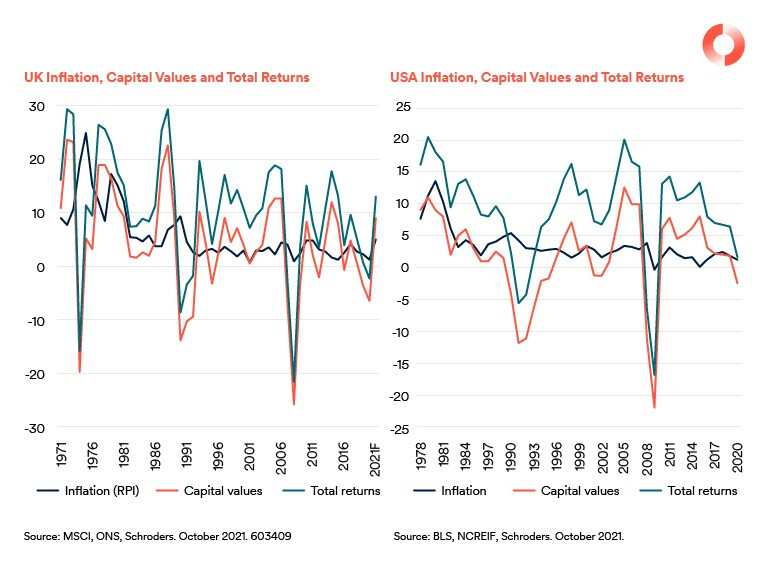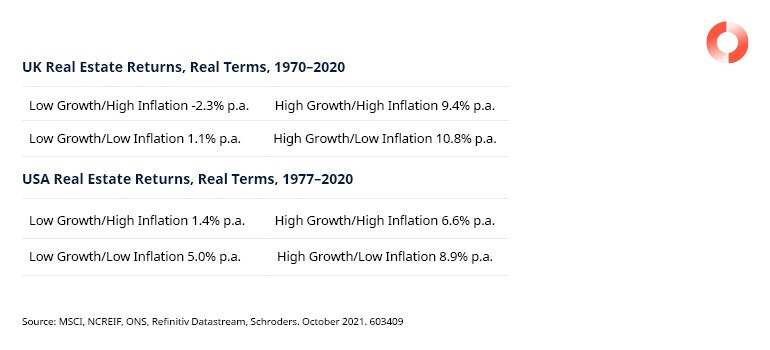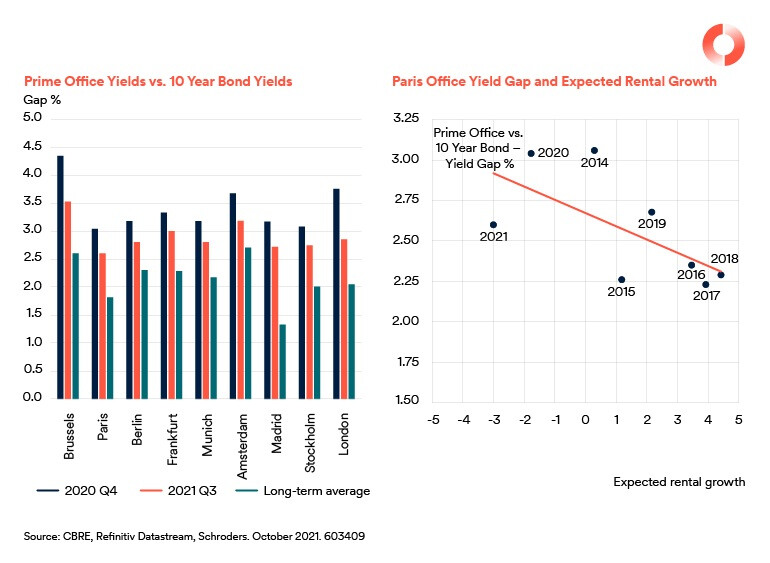What does inflation mean for real estate investors?
We ask if real estate can help protect portfolios against a sustained period of inflation.

Authors
The last few months have seen a sharp acceleration in inflation. Inflation in both the eurozone and UK rose above 4% in October, its highest level in more than a decade. Other developed economies have seen a similar increase.
The consensus among central bankers remains that the current surge in prices is temporary. Policymakers expect inflation will slow rapidly in the second half of 2022, as supply chains normalise and the spike in energy prices falls out of the annual comparison.
But what if the consensus is wrong? What if inflation remains higher for a prolonged period of time?
Will real estate protect against inflation?
Several countries are currently experiencing labour shortages. The pandemic has prompted some people to re-evaluate their lifestyle and stop work and there is a risk that the current acceleration in inflation will trigger a wage-price spiral, like those in the 1970s.
Real estate is hailed by many as a good inflation hedge, but does this also hold true in the current scenario of low interest rates and “cost-push” inflation (as opposed to “demand pull” inflation). Simply put, will real estate returns rise in parallel with the price increases?
If we only consider the rent received by landlords then the answer is probably yes.
This reflects the fact that faster inflation will feed through to corporate sales and profits. Tenants can therefore generally afford to pay higher rents, at least in nominal terms.
Looking at the UK real estate market, which has the longest rental income history, the rent received by landlords grew by 10% per annum(p.a.) between 1970-1990 when inflation was equally high (10% p.a.) and then slowed to 3% p.a. between 1990-2020 when inflation was lower (to less than 3% p.a.).
In fact, the latter period includes the Covid-19 pandemic, when many retail and leisure businesses were shut and unable to pay their rent. In effect, the nominal growth over the period excluding the pandemic was higher. To make up for the unpaid rent over the past period, we expect rental income to rise by a one-off 8% this year.

The correlation coefficient – the strength of the link - between rent and inflation in the UK over the last 50 years is 0.6 (a correlation coefficient of 1.0 means the two move up and down together). It would probably be stronger, but the traditional commercial lease creates a lag, because rents are only adjusted to market levels every five years.
While five year rent reviews are still common in the UK, we are seeing a shift towards either rents which are based on tenants’ turnover, particularly in the retail and leisure sectors, or indexed-linked rents which are the norm in most of continental Europe. However, even with a portfolio of index-linked rents the correlation with inflation will probably never quite reach 1 for a number of reasons.
First, index-linked rents may be subject to a cap (maximum increase), or collar (minimum). Leases may specify a cumulative percentage increase in prices before rents can be adjusted, which is common in Germany.
Second, the natural churn of tenants means that there will always be some units which have just become vacant, or tenants who have just signed a new lease and are benefiting from a rent free period.
Third, rents reflect the local balance between the demand and supply of space. Rents may fall regardless of general inflation, if there is a recession, or a structural decline in demand (e.g. department stores), or a building boom.
Leaving these exceptions aside, the data suggest that the rental income on real estate should provide investors with decent protection against faster inflation.
But income is only part of the equation...
However, we also need to consider the capital value component of total returns. Capital values are driven by rents and by movements in the yields applied by valuers. These yields are in turn related to inflation expectations (the yield being the “short cut” of the discount rate applied on future income, to compensate for risk and inflation).
In common with bonds, an increase in real estate yields will depress capital values, whereas a fall in yields will lift capital values. However, real estate yields are not tied mechanically to bond yields, because although they are influenced by them, they also reflect investors’ expectations for future rental growth. Consequently, there have been periods, usually during a period of sustained strong economic growth, when bond yields have risen on expectations of future interest rate rises, whilst real estate yields have fallen as a result of outpacing rental growth expectations.
As the charts below reveal, capital values in the UK and USA have sometimes failed to respond to increases in inflation rates, at least in the short-term. In both countries capital vales fell in 1990 as inflation accelerated and interest rates rose and there was a similar episode in the UK in 1974. Looking across all eight markets where we have long-run real estate data, suggests that there is little relationship between total returns and inflation in the short-run.


If we measure real estate returns in real terms adjusted for inflation then - in general - a combination of high economic growth and low inflation is more favourable than either a high growth / high inflation environment, or a low growth / high inflation environment.
This is because of the direct relationship between the economy, occupier demand, rental growth and expectations for future rental growth. In addition, higher inflation will usually lead to higher interest rates, which increase the cost of capital and depress economic growth. On balance, real estate returns are more directly sensitive to economic growth than to inflation.

Turning to the current market, another key question is how far would bond yields have to rise before real estate yields reacted? The answer differs between prime and secondary real estate.
At present, even though they have narrowed in 2021 as bond yields have risen, the gaps between 10 year bonds and prime office yields in Europe’s major cities are still well above their long-term averages (see left hand chart below). This suggests that there is room for bond yields to rise further before yields in real estate will.
However, the gaps do not exist in a vacuum. If you look at the chart on the right, below, you will see how the gap between bond yields and prime office yields in Paris has varied over the past few years. Rationally, investors demand a bigger gap when rents are expected to fall (e.g. the 2020 dot) and will accept a narrower gap when rents are expected to rise (e.g. the 2017 dot).

The demand for high quality offices in Europe is now starting to recover as companies focus on buildings with strong ESG credentials (we have already seen an increase in prime rents in London and Stockholm). Assuming the recovery in prime rents gathers momentum, we think that 10 year bond yields could probably rise by another 0.75-1% before prime office yields in Europe reacted. Therefore the threshold for 10 year bond yields is probably somewhere between 0.5%- 0.75% in Germany (around -0.3% as of end November) and 1.75-2.0% in the UK, respectively (around 0.8% end of November).
What about secondary real estate? On the one-hand, the higher level of yields on secondary real estate and the bigger gap with bonds yields, means that secondary yields might be less sensitive to an increase in bond yields. On the other hand, the fact that secondary assets are more at risk of vacancy in a contracting market and therefore have less potential for income growth, means that these yields could be more sensitive.
MSCI data for the UK indicates that secondary real estate yields and total returns generally have a higher correlation with bond yields than prime yields and total returns, although the differences are small. That suggests that the point at which an increase in bond yields triggers an increase in real estate yields is probably slightly lower for secondary real estate than prime.
Our last question, is how long would it take for real estate yields to adjust to a jump in bond yields, such that capital values stabilised and total returns then settled at a permanently higher level in nominal terms? An analysis of UK data measuring the correlation coefficient between total returns and inflation, over different rolling periods since 1970, suggests that in the past the adjustment process has taken around five years. However, in future the adjustment might be quicker, thanks to the improvement in market transparency and liquidity over the last 25 years.
Imperfectly protected
In conclusion, real estate is only a partial hedge for inflation. While rents should broadly keep pace with inflation, capital values and total returns are sensitive to interest rates. A lot therefore depends on whether central banks decide on a sharp, or modest tightening of monetary policy over the next 12 months.
That in turn will largely depend on whether the current bout of inflation leads to an increase in peoples expectations for future inflation and demands for higher wages, which would force central banks to act. A big hike in interest rates, in response to a wage-price spiral, would have a knock-on impact on real estate yields and depress capital values and returns. A limited increase in interest rates might have no impact, particularly if rents are rising in most parts of the market.
Subscribe to our insights
Visit our preference centre, where you can choose which Schroders Insights you would like to receive.
Authors
Topics